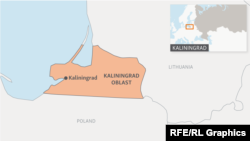KALININGRAD, Russia -- A court in the town of Chernyakhovsk has ruled that the coat of arms of the old town in Russia's far western exclave of Kaliningrad is illegal because it carries "elements of foreign culture."
The Chernyakhovsk's city prosecutor's office said the move it initiated was approved by the court on September 16.
The town's current coat of arms, adopted in 2002, was based on the historic coat of arms of the town that before 1946 was known under its original Prussian name -- Insterburg.
The coat of arms in question has a picture of a Prussian man with a horn and the Latin initials G.F. for the Regent of Prussia George Frederick, margrave of Brandenburg-Ansbach (1543–1603), who gave Insterburg the status of town and with it his family coat of arms.
The court ruled that Russian laws do not allow the use of foreign languages and symbols in Russian state symbols and ordered the town "to remove any violations of the law."
Several other towns in the region have announced their intentions in recent months to change their coat of arms as tensions mount between Russia and the West following Moscow's annexation of Ukraine's Crimea in 2014 and its support for pro-Russian separatists in Ukraine's east.
Earlier this year, authorities in the town of Baltiisk, which until 1946 was known as Pillau, announced their intention to change its coat of arms because it contained the crown of Frederick William I of Prussia.
Authorities in Zelenograd, originally Cranz, said several months ago that they wanted to change their town's coat of arms because it might have been granted by Nazi Germany's governor of East Prussia, Erich Koch.
Russia's Baltic Sea exclave of Kaliningrad, sandwiched between Lithuania and Poland, became part of the Soviet Union after World War II. The original names of German towns and cities were changed in the exclave in 1946, a year after joining the Soviet Union.










